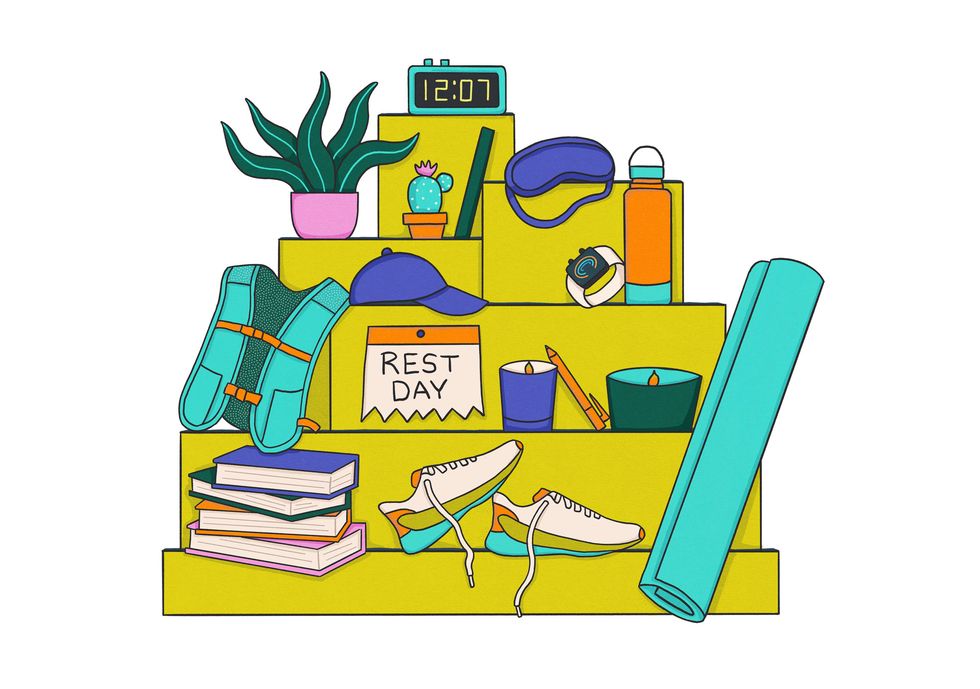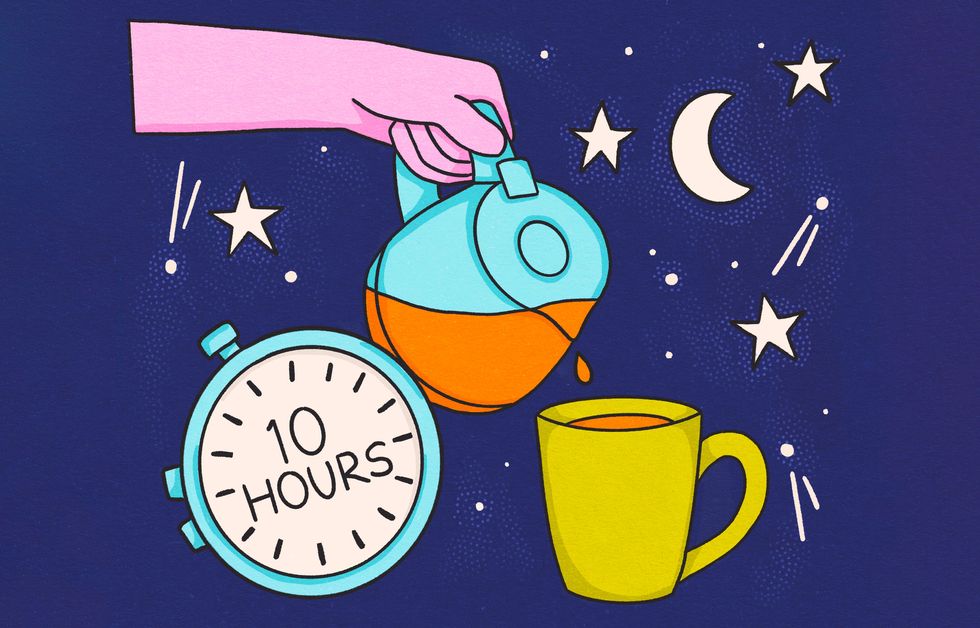The 3 Best Recovery Tricks Known To Science
Reaping the benefits of training is all about how you spend the time that you're not running.
You only benefit from the training you recover from.
Workouts alone are not what make you faster and stronger, says Michael Joyner, a physiologist at the Mayo Clinic. Fitness gains occur as tissue repairs itself. Without adequate rest, muscle damage from subsequent workouts builds, and eventually runners can reach a point of diminishing returns, Joyner says. Where that point lies is individual, but many athletes have run themselves into nearly career-ending periods of overtraining. Ultra-marathoner Anna Frost, for example, had to take most of a year away from running, and marathon standout Ryan Hall retired at age 33 due to overtraining. To avoid a similar fate, carefully track how you’re responding to your training — you want to notice yourself getting stronger and faster over time — and stay alert for signs of overtraining, like fatigue that you can’t shake. Often in those cases, the problem stems from a lack of recovery rather than the amount of training, says Dr Shona Halson a professor at Australian Catholic University’s School of Behavioural and Health Sciences
The quality of your recovery is everything. Here’s how to leverage all the time in between your workouts to maximise your fitness and become a better, stronger runner. —Christie Aschwanden
When I first began reporting my book on exercise recovery, Good to Go, in 2015, I came to the subject eager to find new products and hacks that could expedite my return to readiness after a hard run. I knew that recovery was fundamental to my performance, and that lesson became more acute as I aged. Like everyone else, I’m getting older all the time, and my recovery slowed with each passing year. So I was hungry to find quick fixes that could speed things along.
Over the course of my research, I interviewed hundreds of experts and read close to a thousand scientific papers. Instead of new tricks, I discovered that the most effective recovery tools aren’t novel products to buy or gadgets to use. They’re life habits that improve your recovery, yes, but also your overall wellness.
1 Sleep. A lot. A full night of sleep — between seven and nine hours — is the most effective recovery strategy ever identified. During deep sleep, your body releases a growth hormone that helps to repair exercise-induced muscle damage, says Dr Amy Bender, the director of clinical sleep science at Cerebra Medical, a sleep technology startup, and a researcher at the University of Calgary. Very few people can get by on less than that, Bender says.
Your sleep needs will vary depending on the intensity of your running. Generally, the harder the workout, Bender says, the more sleep you need.
If you can’t rely on a long night of sleep, try napping, Bender says. An early afternoon nap can improve performance in runners who got less than seven hours of sleep the night before, according to a 2018 study in the European Journal of Sport Science. The ideal nap is 30 minutes or less, ending before 4 p.m., Bender says. If you had a restless night, then a longer nap of up to 90 minutes might help you improve recovery — but more than that, she says, and you risk disrupting your nighttime sleep patterns.
2 Take a rest day each week. To make needed repairs, like fixing damaged muscle fibres, your body needs rest days. Hard training can deplete your glycogen (the fuel stored in your muscles), dehydrate you, and leave micro-damage in your muscles. Runners should take at least one day a week of either complete rest or what Joyner calls “active rest,” like a light jog session of maybe 20 or 30 minutes — you should be able to carry a regular conversation, and your heart rate should be well below your threshold — to get warm and loosen up. “This helps avoid the stiffness and sluggish feeling from doing nothing,” he says. If you’re feeling more fatigued than usual on a certain week, you can take an extra rest day or two.
Fatigue is often framed as a purely physical process, but hard training can take a psychological toll as well, Joyner says, as it requires a high level of focus. A day off can help refresh your mood and your mindset. “The mental break ensures you are primed and ready to focus on your next big training effort,” Joyner says.
3 De-stress yourself. Life stress, says Halson, can produce a lot of the same physiological responses as intense exercise: sweat, elevated heart rate, and muscle tension. As a result, stress can impair your body’s ability to recover from exercise, as it hinders the respite your body needs from physiological pressures, leaving you with less energy to bounce back from training. Devise a strategy for managing your stress, Halson recommends, and build extra rest into your training plan during periods when stress is unavoidable.
A recovery ritual could include writing a list of worries or to-dos before bedtime to offload any thoughts that might keep you awake. Some runners find that meditation apps help them quiet their mind. Or try curling up on the couch with a good book for an afternoon. Michael Wardian, three-time winner of the U.S. 50K championship, says he likes to relax by listening to music or an audiobook.
The important thing is that you’re giving yourself time to slow down, without any expectation of productivity.—C.A.
5 Go-to Habits That Ensure Sound Sleep Every Night
Maintain a Routine
Going to bed and getting up around the same time helps your body develop consistent sleep rhythms. Set a no-exceptions bedtime to prevent “revenge sleep procrastination” — the habit of making up for an overscheduled daytime by staying up late for leisure time.
Stay away from blue light in the evening
Blue light can reduce your melatonin levels and decrease your deep sleep, Bender says. Use an app or device setting that filters out blue light at night, then turn off your screens completely at least 30 minutes before bedtime.
Keep your bedroom dark and cool
15° to 20°C is ideal. Wear a sleep mask or install blackout curtains to prevent light from intruding on your sleep cycle. Try to step outside after you wake up. Exposure to light in the early hours keeps your circadian rhythms in sync, which can ensure that you sleep when you’re supposed to. —C.A.
Don’t Fall for These Recovery Myths

A lot of what passes for recovery science is actually just folklore, speculation, or wishful thinking. Here’s the truth about the most common recovery myths.
The notion that there’s only a short period of time to replenish the energy depleted during a workout or else your recovery will be ruined is simply not true, says Louise Burke, PhD, a sports nutrition scientist at Australian Catholic University. “Your body doesn’t have a clock ticking that says, ‘Oh, you’re over the 30-minute window.’”
In the rare instance when you’re in the middle of repeated, hard efforts without much time in between — say, a track meet where you’ll be doing multiple heats on the same day — then timing out your nutrition matters. And yes, you need carbs and protein after a run. But otherwise, there’s no harm in waiting until you can get a good meal.
The rationale behind ice baths as a recovery tool is that they facilitate blood flow, which can speed the removal of waste products like lactate in the muscle, Halon says. But icing can be detrimental for replacing glycogen in your muscles, says Dr Luc van Loon, a human biology researcher at Maastricht University Medical Centre in the Netherlands. Numerous studies suggest that icing might actually slow blood flow.
One 2013 experiment, led by researchers in Taiwan, had volunteers perform a set of arm exercises, then ice their muscles. Compared to the controls, who did not ice, these participants felt more fatigue at 72 hours and more markers of muscle damage. The researchers concluded that icing may delay recovery from muscle-damaging exercise.
Another study, published in the Journal of Physiology in 2019, found that when recreational athletes used cold-water immersion after resistance exercise, the uptake of dietary protein in their muscles went down, along with a drop in protein synthesis in the muscle tissue, says van Loon. The study looked at strength training, not aerobic exercise, so “we cannot necessarily translate these findings to endurance athletes,” he says, while adding that “there is no one-size-fits-all” answer here.
Ibuprofen is such a popular pre-workout drug that it’s gained the nickname “vitamin I.” But runners should understand that “there is no performance or physiological rationale for using ibuprofen during heavy training or competitive endurance events,” says Dr David Nieman, the director of the Human Performance Laboratory at Appalachian State University.
Nieman led a study of 54 runners in the Western States Endurance run, a 100-mile run through the Sierra Nevadas. It found that runners who had been asked to abstain from taking ibuprofen during the race had no less soreness or muscle pain, and they had lower levels of inflammation than the runners who’d popped ibuprofen. Runners who’d taken the drug also showed higher levels of oxidative stress (the accumulation of oxygen-reactive molecules in cells and tissues, which can damage cells in some cases).
The authors of a 2016 analysis in Research in Sports Medicine: An International Journal found no evidence to suggest that stretching can reduce delayed-onset muscle soreness or chronic injury in long-distance runners. “Some runners stretch just because it feels good,” says Dr Rob Herbert, a professor at Neuroscience Research Australia. “If you feel it is helping you, you might as well do it.”
Lactic acid is one of the buzziest words in recovery, but the truth is that it isn’t what makes you sore. Yes, lactate levels rise when you’re running at a high intensity, so it has a relation to fatigue. But it’s not the driving factor, and there’s no reason it needs to be flushed out, says Joyner.
“Lactate clears itself naturally,” Halson says, and it usually does so quickly — before you have time to complete any recovery modality. “The only time lactic acid becomes a problem is if you are competing again in a very short period of time.” — C.A.
Recovery Strategies for Every Goal

Marathons and Half Marathons
The longer the distance, and the higher the weekly mileage, the more carefully runners should consider where to place recovery days on the training schedule, says Steve Magness, a sports performance expert. “After the long run, you’re going to be beat up in terms of mechanical fatigue,” he says. At longer distances, fatigue results in some breakdown in your form while you’re running (usually late into a long run). Marathoners (and half-ers) may want to schedule the day off after that long run, Magness says.
Half to 5K
At this level, it’s all about finding what works for you, says Darrell Barnes, an Indianapolis-based athletic trainer at Aspire Performance Rehab. Some middle-distance runners he trains put in longer cooldown jogs after hard efforts to gradually lower heart rate and regulate blood flow. Shorter-distance athletes jump right to soft-tissue treatment or self-massage tools. Either way, Barnes says, the point of the cooldown is the same: If your brain believes it’s aiding your recovery, it probably is. “You want to promote an environment of healing, which means that you’re giving your body the right fuel to recover,” he says.
Running Streak
What streakers may need to focus on most is bringing their systems down to resting mode as efficiently as possible. Heather Milton, exercise physiologist supervisor at the NYU Langone Sports Performance Center, suggests a breathing exercise to help counteract the fight-or-flight stress response that running creates: Breathe in and slowly exhale out of your mouth, drawing your lower abs toward your back and engaging pelvic floor muscles. Then hold your stomach in for 10 seconds, breathing normally throughout. Repeat 10 to 20 times.
Streakers should pay close attention to what they eat, says Dr Stephanie Howe. “Muscle damage is building. Protein helps maintain lean body mass and helps you recover from running every single day.” Streakers can also reframe their lower-mileage days and think of them as active recovery: Jog slowly, don’t go too far. — Erin Strout
The Runner’s World Day Off
Experts weigh in on how to structure your rest days to harness recovery and get the most out of your running.
Go outside first thing in the morning.
After you wake up, head outdoors for at least 15 minutes. Ultraviolet light neurologically triggers the timing of cortisol and melatonin release, which are hormones that influence our sleeping patterns, says Dr. Andrew Huberman, an associate professor of neurobiology and psychiatry at Stanford University. “Going outside for the light is better than sitting by a window,” according to Huberman, “because glass filters out some of the ultraviolet light that assists the clock-setting.”
Sunlight helps regulate your circadian clock, facilitating a more natural sleep process instead of relying on something like melatonin supplements — which may help you fall asleep faster, but won’t necessarily get you to the deeper sleep that is vital to recovery — says Thomas Gesser, an assistant Olympic sports performance coach at Stanford University, where he coaches the university’s track-and-field and cross-country teams.
Eat up…
Just because you’re not as active on a rest day doesn’t mean you should restrict your calories, says Dr Stephanie Howe, a coach and ultrarunner. The average runner takes about 48 hours to recover from hard workouts, so your nutrition is important even days after your run is over. Plus, sometimes your appetite is suppressed on days you’ve trained hard.
Eat within an hour of waking up to get your blood flow going, Howe says. A recovery-day breakfast can include more muscle-repairing protein than on days with hard runs, when we focus heavily on fueling with carbs. Try a big slice of sourdough toast with an egg and avocado, a bowl of thick Greek yoghurt, or toast with nut butter. Howe enjoys savoury oatmeal with an egg and butter over it.
“It’s a great day to get lots of nutrients, because your body can absorb them a little bit better,” she says. “You don’t have to worry if it’s going to sit poorly in your stomach during a run.” For lunch, make a nutrient-rich salad. Ideally, it should have dark leafy greens, lots of colourful vegetables (carrots, beets, radishes), some fat (like an avocado), a protein (egg, chicken, lentils, or beans), and an olive oil–based vinaigrette.
Protein should be the star of dinner with a vegetable as the side, as you’re still digesting the veggie-heavy lunch — think salmon and roasted broccoli with rice, or chicken noodle soup with a side of bread for digestible carbs, to prepare yourself to get back to running in the morning.
Snacks are a big part of the rest day, too — and a time to treat yourself if you feel like it. Eat a doughnut, have a mid-morning cappuccino, or meet a friend for a glass of wine. If you have a long stretch between meals, a handful of nuts or some yoghurt with granola still works — as long as you’re eating when you’re hungry. “You need to recover from those days that potentially your energy expenditure was more than you could fulfil,” Howe says.
…And hydrate.
Without a sweat session, we may forget to drink water, but it’s still critical. The body relies on fluid for proper circulation — dehydration places greater strain on the cardiovascular system, Howe says. Hydration also keeps our joints lubricated.
How much water you should drink, she adds, varies based on sex, body composition, age, and other factors. An easy way to figure out if your hydration is meeting your needs, Howe says, is looking at the colour of your urine — if it’s nearly clear or pale yellow, you’re doing well. If it’s medium or dark yellow, you need to drink more.
Move a little bit — but not too much.
Most experts agree that the rest day should include a little bit of movement—what’s known as active recovery. Sitting all day won’t get the blood circulating to promote muscle healing, says Dr. Todd Arnold, a sports medicine physician. “Doing nothing makes you tight,” he says. Arnold recommends trying 20 minutes of a few sets of movements like push-ups and sit-ups, foam rolling, and something physical but fun — for him, it’s going outside and playing with his dogs.
Resist doing too much and defeating the purpose of the day, Gesser says. “I don’t think you just want to be on the couch, completely stagnant. But if you just want to have a lazy day, that is totally okay,” he says. “Get up, go walk around a little bit, and do things that make you feel like you’re enjoying the day.”
Breathe with purpose.
Recovery is as much for your mind as it is for your body. Gesser wants his athletes to feel centred, calm, and peaceful. “Go ahead and have a hot chocolate and relax,” he says. “Find the things that make you happy.”
Practising breathing techniques, which are shown to decrease anxiety, helps the nervous system relax and turn attention away from stressful thoughts. Gesser recommends that his runners set aside 15 or 20 minutes to focus on breathing in a quiet space — either sitting or lying down. He suggests two protocols. The first is a double exhale-to-inhale ratio: Exhale for four seconds, pause for a second, inhale for two seconds, for example. Do that for two minutes at a time, resume normal breathing, and repeat for 15 minutes. The other is box breathing: Inhale two seconds, hold two seconds, exhale two seconds, hold two seconds, and repeat. Any time that you can fit a breathing exercise into your day is a good time to do it, he says, but it’s an especially good way to wind down at the end of the day, before bed. — E.S



